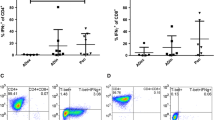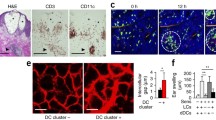Abstract
Membrane molecules such as CD36 (OKM5), intercellular adhesion molecule-1 (ICAM-1, CD54), gamma interferon-induced protein 10 (γ-IP10) and IL-1 are induced and/or upregulated in psoriatic epidermis. These molecules have important accessory, trafficking or signalling functions in the immune system and also play a role in the pathophysiology of psoriasis. The relevance of adhesion molecules, CD36 and epidermal IL-1 in psoriasis was studied in vitro in the autologous mixed epidermal cell-T lymphocyte reaction (MECLR). Their level of expression was quantitated in epidermal cell suspensions (ECS) from patients with psoriasis and their function was assessed by blocking with specific mAbs and antisera or by depleting CD36+ cells from the ECS prior to the MECLR. ECS from psoriatic lesions contained increased numbers of CD36+ (23±12%), ICAM-1+ (31±14%) and IL-1+ (57±21%) cells. The autologous MECLR was inhibited in saaples from all patients by mAb to CD2 (LFA-2), CD11a (LFA-1α), CD18 (LFA-1β), ICAM-1, CD58 (LFA-3) and an antiserum to IL-1β. Thus, adhesion molecules facilitate inflammation in psoriasis not only via adhesion and recruitment of T lymphocyte in psoriatic lesions, but also via activation of T cells. Furthermore CD36 molecules on psoriatic epidermal cells do not costimulate autologous T lymphocytes in psoriasis. The observed costimulatory function of IL-1β in the MECLR emphasizes its relevance in psoriasis.
Similar content being viewed by others
References
Baadsgaard O, Fox DA, Cooper KD (1988) Human epidermal cells from ultraviolet light-exposed skin preferentially activate autoreactive CD4+2H4+ suppressor-inducer lymphocytes and CD8+ suppressor/cytotoxic lymphocytes. J Immunol 140:1738–1744
Baadsgaard O, Tong P, Elder JT, Hansen ER, Ho V, Hammerberg C, Lange-Vejlsgaard G, Fox DA, Fisher G, Chan LS (1990) UM4D4+ (CDw60) T cells are compartmentalized into psoriatic skin and release lymphokines that induce a keratinocyte phenotype expressed in psoriatic lesions. J Invest Dermatol 95:275–282
Barker JN, Markey AC, Allen MH, MacDonald DM (1989) Keratinocyte expression of OKM5 antigen in inflammatory cutaneous disease. Br J Dermatol 120:613–818
Blanton RA, Kupper TS, McDougal JK, Dower S (1986) Regulation of interleukin 1 and its receptor in human keratinocytes. Proc Natl Acad Sci USA 86:1273–1277
Camp R, Fincham N, Ross J, Bird C, Gearing A (1991) Potent inflammatory properties in human skin of interleukin-1 alphalike material isolated from normal skin. J Invest Dermatol 96: 294–295
Chang EY, Hammerberg C, Fisher G, Baadsgaard O, Ellis CN, Voorhees JJ, Cooper KD (1992) T-cell activation is potentiated by cytokines released by lesional psoriatic, but not normal, epidermis. Arch Dermatol 128:1479–1486
Chin YH, Falanga V, Cai JP (1990) Lymphocyte adhesion to psoriatic dermal endothelium: mechanism and modulation. J Invest Dermatol 95:29S-31S
Cooper KD, Hammerberg C, Baadsgaard O, Elder JT, Chan LS, Sauder DN, Voorhees JJ, Fisher G (1990) IL-1 activity is reduced in psoriatic skin. Decreased IL-1 alpha and increased nonfunctional IL-1 beta. J Immunol 144:4593–4603
Enk AH, Angeloni VL, Udey MC, Katz SI (1993) An essential role for Langerhans cell-derived IL-1 beta in the initiation of primary immune responses in skin. J Immunol 150:3698–3704
Gottlieb AB, Luster AD, Posnett DN, Carter DM (1989) Detection of a gamma interferon-induced protein IP-10 in psoriatic plaques. J Exp Med 168:941–948
Griffiths CE, Voorhees JJ, Nickoloff BJ (1989) Characterization of intercellular adhesion molecule-1 and HLA-DR expression in normal and inflamed skin: modulation by recombinant gamma interferon and tumor necrosis factor. J Am Acad Dermatol 20:617–629
Helle M, Boeije L, Groot E de, Vos A de, Aarden L (1991) Sensitive ELISA for interleukin-6. Detection of IL-6 in biological fluids: synovial fluids and sera. J Immunol Methods 138: 47–56
Makgoba MW, Sanders ME, Shaw S (1989) The CD2-LFA-3 and LFA-1-ICAM-1 pathways: relevance to T cell recognition. Immunol Today 10:417–422
McKean DJ, Podzorski R, Bell MP, Nilson AE, Huntoon CJ, Slack J, Dower S, Sims J (1993) Murine T helper cell-2 lymphocytes express type I and type II IL-1 receptors, but only the type I receptor mediates costimulatory activity. J Immunol 151:3500–3510
Nickoloff BJ (1991) The cytokine network in psoriasis. Arch Dermatol 127:871–884
Nickoloff BJ, Mitra RS, Green J, Zheng XG, Shimizu Y, Thompson C, Turka LA (1993) Accessory cell function of keratinocytes for superantigens. Dependence on lymphocyte function-associated antigen-1/intercellular adhesion molecule-1 interaction. J Immunol 150:2148–2159
Nilsson H, Johansson C, Scheynius A (1987) Removal of Langerhans cells from human epidermal cell suspensions by immunomagnetic particles. J Immunol Methods 105:165–169
Prens EP, Benne K, Van Damme J, Bakkus M, Brakel K, Benner R, Joost T van (1990) Interleukin-1 and interleukin-6 in psoriasis. J Invest Dermatol 95:121S-124S
Prens EP, Benne K, Joost T van, Benner R (1991) The autologous mixed epidermal cell-T lymphocyte reaction is elevated in psoriasis: a crucial role for HLA-DR+/CDla− antigen presenting cells. J Invest Dermatol 96:880–887
Prens EP, Benne K, Joost T van, Benner R (1991) Differential role of lymphocyte function-associated antigens in the activation of nickel-specific peripheral blood T lymphocytes. J Invest Dermatol 97:885–891
Schopf RE, Hoffmann A, Jung M, Morsches B, Bork K (1986) Stimulation of T cells by autologous mononuclear leukocytes and epidermal cells in psoriasis. Arch Dermatol Res 279:89–94
Shen HH, Talle MA, Goldstein G, Chess L (1983) Functional subsets of human monocytes defined by monoclonal antibodies: a distinct subset of monocytes contains the cells capable of inducing the autologous mixed lymphocyte culture. J Immunol 130:698–705
Simon IC, Cruz PJ, Bergstresser PR, Davis LS, Tigelaar RE (1991) Phorbol myristate acetate-activated keratinocytes stimulate proliferation of resting peripheral blood mononuclear lymphocytes via a MHC-independent, but protein kinase C-and intercellular adhesion molecule-1-dependent, mechanism. J Immunol 146:476–484
Stoof TJ, Mitra RS, Sarma V, Dixit VM, Nickoloff BJ (1992) Keratinocyte activation following T-lymphocyte binding. J Invest Dermatol 98:92–95
Teunissen MBM, Wormmeester J, Rongen HAH, Kapsenberg ML, Bos JD (1991) Conversion of human epidermal Langerhans cells into interdigitating cells in vitro is not associated with functional maturation. Eur J Dermatol 1:45–54
Udey MC, Peck RD, Pentland AP, Schreiner GF, Lefkowith JB (1991) Antigen-presenting cells in essential fatty acid-deficient murine epidermis: keratinocytes bearing class II (Ia) antigens may potentiate the accessory cell function of Langerhans cells. J Invest Dermatol 96:950–958
Van Damme J, De Ley M, Van Snick J, Dinarello CA, Billiau A (1987) The role of interferon-beta 1 and the 26-kDa protein (interferon beta 2) as mediators of the antiviral effect of interleukin 1 and tumor necrosis factor. J Immunol 139:1867–1872
Van Dongen JJM, Adriaansen HJ, Hooijkaas H (1987) Immunological marker analysis of cells in the various hematopoietic differentiation stages and their malignant counterparts. In: Ruiter DJ, Fleuren J, Warnaar SO (eds) Application of monoclonal antibodies in tumor pathology. M. Nijhoff, Dordrecht, pp 87–116
Author information
Authors and Affiliations
Rights and permissions
About this article
Cite this article
Prens, E., Hooft-Benne, K., Tank, B. et al. Adhesion molecules and IL-1 costimulate T lymphocytes in the autologous MECLR in psoriasis. Arch Dermatol Res 288, 68–73 (1996). https://doi.org/10.1007/BF02505046
Received:
Issue Date:
DOI: https://doi.org/10.1007/BF02505046




